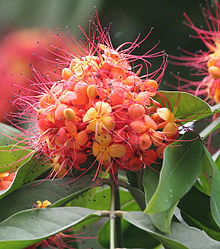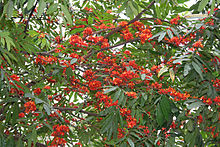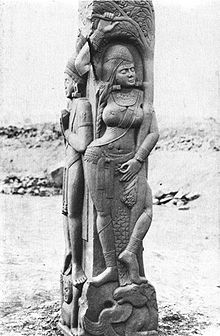- Saraca asoca
-
Ashoka tree 
Ashoka flower bunch Conservation status Scientific classification Kingdom: Plantae (unranked): Angiosperms (unranked): Eudicots (unranked): Rosids Order: Fabales Family: Fabaceae Genus: Saraca Species: S. asoca Binomial name Saraca asoca
(Roxb.) WildeSynonyms Saraca indica Linnaeus
Saraca asoca (the Ashoka tree; lit., "sorrow-less") is a plant belonging to the Caesalpiniaceae subfamily of the legume family.[1] It is an important tree in the cultural traditions of the Indian Subcontinent and adjacent areas.
Contents
Description
The Ashoka is a rain-forest tree. Its original distribution was in the central areas of the Deccan plateau, as well as the middle section of the Western Ghats in the western coastal zone of the Indian Subcontinent.
The Ashoka is prized for its beautiful foliage and fragrant flowers. It is a very handsome, small, erect evergreen tree, with deep green leaves growing in dense clusters.
Its flowering season is around February to April. The Ashoka flowers come in heavy, lush bunches. They are bright orange-yellow in color, turning red before wilting.
As a wild tree, the Ashoka is a vulnerable species. It is becoming rarer in its natural habitat, but isolated wild Ashoka trees are still to be found in the foothills of central and eastern Himalayas, in scattered locations of the northern plains of India as well as on the west coast of the Subcontinent near Mumbai.
There are a few varieties of the Ashoka tree. One variety is larger and highly spreading. The columnar varieties are common in cultivation.
it is also used for medical purposes.
Mythology and tradition
The ashoka tree is considered sacred throughout the Indian subcontinent, especially in India and Sri Lanka. This tree has many folklorical, religious and literary associations in the region. Highly valued as well for its handsome appearance and the color and abundance of its flowers, the ashoka tree is often found in royal palace compounds and gardens as well as close to temples throughout India.
The ashoka tree is closely associated with the Yakshi mythological beings. One of the recurring elements in Indian art, often found at gates of Buddhist and Hindu temples, is the sculpture of a Yakshi with her foot on the trunk and her hands holding the branch of a flowering ashoka tree. As an artistic element, often the tree and the Yakshi are subject to heavy stylization. Some authors hold that the young girl at the foot of this tree is based on an ancient fertility symbol.[2]
Yakshis under the ashoka tree, were also important in early Buddhist monuments as a decorative element and are found in many ancient Buddhist archaeological sites. With the passing of the centuries the yakshi under the ashoka tree became a standard decorative element of Hindu Indian sculpture and was integrated into Indian temple architecture as salabhanjika, because there is often a confusion between the ashoka tree and the sal tree (Shorea robusta) in the ancient literature of the Indian Subcontinent.[3]
This tree is also regarded with veneration in Jainism. In the Jain tradition Mahavira is said to have renounced the world under this kind of tree in Vaishali.
In Hinduism the ashoka is considered a sacred tree. Not counting a multitude of local traditions connected to it, the ashoka tree is worshipped in Chaitra,[4] the first month of the Hindu Calendar.[4] It is also associated with Kamadeva, the Hindu god of Love, who included an Ashoka blossom among the five flowers in his quiver.[5] Hence, the ashoka tree is often mentioned in classical Indian religious and amorous poetry, having at least 16 different names in Sanskrit referring to the tree or its flowers.[6]
In Mahākāvya, or Indian epic poetry, the ashoka tree is mentioned in the Ramayana in reference to the Ashoka Vatika (garden of Ashoka trees) where Hanuman first meets Sita.
Other trees called 'Ashoka tree'
A popular tree simply referred to, and also known as Ashoka tree of the unrelated genus Polyalthia longifolia (false Ashoka tree), is bred to resemble the growth pattern of erect pillar-like mediterranean cypress trees, it is a popular park and garden plant, much used in landscaping on the Indian Subcontinent.
Other names
This tree has a multitude of names in Indian literature. Some names for the Ashoka tree and its flowers include:
- In Sanskrit: Sita-Ashoka, Anganapriya, Ashopalava, Ashoka, Asupala, Apashaka, Ashoka, Hemapushpa, Kankeli, Madhupushpa, Pindapushpa, Pindipushpa, Vanjula, Vishoka, Vichitra.
- Other languages: Thawgabo, Thawka (Burmese), Vand ichitrah, Vanjulam (Hindi), Asok (Bengali), Ashoka (Oriya), Asogam (Tamil), Asokam (Malayalam), Asokamu, Vanjulamu (Telugu), Sokanam โสกน้ำ (Thai), Diyaratmal, Diyeratembela (Sinhala), Nikabilissa (Divehi), Achenge, Akshth, Ashanke, Kenkalimara, (Kannada), Gapis, Tengalan (Malay).[7]
See also
- Indian epics
- Kurincippattu
- Sitala
- The birth of Buddha (Lalitavistara)
References
- ^ Ashoka - Herb Information
- ^ Heinrich Zimmer, Myths and Symbols in Indian Art and Civilization. (1946)
- ^ Buddhistische Bilderwelt: Hans Wolfgang Schumann, Ein ikonographisches Handbuch des Mahayana- und Tantrayana-Buddhismus. Eugen Diederichs Verlag. Cologne. ISBN 3-424-00897-4, ISBN 978-3-424-00897-5
- ^ a b Ashoka Tree
- ^ Cowen, D. V. (1984). Flowering Trees and Shrubs in India, Sixth Edition. Bombay: THACKER and Co. Ltd.. p. 5.
- ^ Eckard Schleberger, Die indische Götterwelt. Gestalt, Ausdruck und Sinnbild Eugen Diederich Verlag. Cologne. ISBN 3-424-00898-2, ISBN 978-3-424-00898-2
- ^ Sita Ashok (Saraca indica) as medicinal herb in Chhattisgarh, India: Natural Occurrence, Traditional Medicinal knowledge and Trade
External links
Categories:- IUCN Red List vulnerable species
- Saraca
- Trees of India
- Hindu plant worship
- Buddhist mythology
- Indian folklore
- Vulnerable plants
- Jain symbols
Wikimedia Foundation. 2010.





